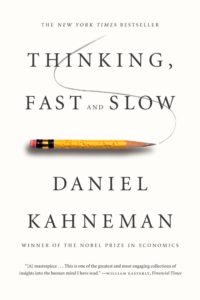Quotes from Thinking, Fast and Slow by Daniel Kahneman
“You meet a woman named Joan at a party and find her personable and easy to talk to. Now her name comes up as someone who could be asked to contribute to a charity. What do you know about Joan’s generosity? The correct answer is that you know virtually nothing, because there is little reason to believe that people who are agreeable in social situations are also generous contributors to charities. But you like Joan and you will retrieve the feeling of liking her when you think of her. You also like generosity and generous people. By association, you are now predisposed to believe that Joan is generous. And now that you believe she is generous, you probably like Joan even better than you did earlier, because you have added generosity to her pleasant attributes.”

“We are able to communicate with each other because our knowledge of the world and our use of words are largely shared. When I mention a table, without specifying further, you understand that I mean a normal table. You know with certainty that its surface is approximately level and that it has far fewer than 25 legs. We have norms for a vast number of categories, and these norms provide the background for the immediate detection of anonalies such as pregnant men and tattooed aristocrats.
To appreciate the role of norms in communication, consider the sentence: “The large mouse climbed over the trunk of a very small elephant.” I can count on your having norms for the size of mice and elephants that are not too far from mine.The norms specify a typical or average size of these animals, and they also contain information about the range or variability within the category.”
-Daniel Kahnman, Thinking, Fast and Slow
“When confronted with a problem – choosing a chess move or deciding whether to invest in a stock – the machinery of intuitive thought does the best it can. If the individual has relevant expertise, she will recognize the situation, and the intuitive solution that comes to her mind is likely to be correct. This is what happens when a chess master looks at a complex position; the few moves that immediately occur to him are all strong.
When the question is difficult and a skilled solution is not available, intuition still has a shot: an answer may come to mind quickly – but it is not an answer to the original question. The question that the executive faced (should I invest in Ford stock?) was difficult, but the answer to an easier and related question (do I like Ford cars?) came readily to his mind and determined his choice. This is the essence of intuitive heuristics: when faced with a difficult question, we often answer an easier one instead, usually without noticing the substitution.”

“You know that the lines are equally long. If asked about their length, you will say what you know. But you still see the [left] line as longer. You have chosen to believe the measurement, but you cannot prevent System 1 from doing its thing; you cannot decide to see the lines as equals, although you know they are. To resist the illusion, there is only one thing you can do: you must learn to mistrust your impressions of the lengths of lines when fin are attached to them. To implement that rule, you must be able to recognize the illusory pattern and recall what you know about it.
Not all illusions are visual. There are illusions of thought, which we call cognitive illusions.”
“What do you think of Alan and Ben?
Alan: intelligent – industrious – impulsive – critical – stubborn – envious
Ben: envious – stubborn – critical – impulsive – industrious – intelligent
If you are like most of us, you viewed Alan much more favorably than Ben. The initial traits in the list change the very meaning of the traits that appear later. The stubbornness of an intelligent person is seen as likely to be justified and may actually evoke respect, but intelligence in an envious and stubborn person makes him more dangerous.
The sequence in which we observe characteristics of a person is often determined by chance. Sequence matters, however, because the halo effect increases the weight of first impressions, sometimes to the point that subsequent information is mostly wasted.”
“In one of many experiments that were prompted by the litigation about the notorious Exxon Valdez oil spill, participants were asked about their willingness to pay for nets to cover oil ponds in which migratory birds often drown. Different groups of participants stated their willingness to pay to save 2,000, 20,000, or 200,000 birds. In fact, the average contributions of the three groups were $80, $78, and $88 respectively. The number of birds made very little difference. What the participants reacted to, in all three groups, was a prototype – the awful image of a helpless bird drowning, its feathers soaked in thick oil. The almost complete neglect of quantity in such emotional contexts has been confirmed many times.”
“All roses are flowers.
Some flowers fade quickly.
Therefore some roses fade quickly.
A large majority of college students endorse this syllogism as valid. In fact the argument is flawed, because it is possible that there are no roses among the flowers that fade quickly. Just as in the bat-and-ball problem, a plausible answer comes to mind immediately. Overriding it requires hard work – the insistent idea that “it’s true, it’s true!” makes it difficult to check the logic, and most people do not take the trouble to think through the problem. This experiment has discouraging implications for reasoning in everyday life. It suggests that when people believe a conclusion is true, they are also very likely to believe arguments that appear to support it, even when these arguments are unsound.”
“A reliable way to make people believe in falsehoods is frequent repetition, because familiarity is not easily distinguished from truth. Authoritarian institutions and marketers have always known this fact.
But it was psychologists who discovered that you do not have to repeat the entire statement of a fact or idea to make it appear true. People who were repeatedly exposed to the phrase “the body temperature of a chicken” were more likely to accept as true the statement that “the body temperature of a chicken is 144 degrees (or any other arbitrary number). The familiarity of one phrase in the statement sufficed to make the whole statement feel familiar, and therefore true. If you cannot remember the source of a statement, and have no way to relate it to other things you know, you have no option but to go with the sense of cognitive ease.”
“Adolf Hitler was born in 1892.
Adolf Hitler was born in 1887.
Both are false (Hitler was born in 1889), but experiments have shown that the first is more likely to be believed. More advice: if your message is to be printed, use high-quality paper to maximize the contrast between characters and their background. If you use color, you are more likely to be believed if your text is printed in bright blue or red than in middling shades of green, yellow, or pale blue.
If you care about being thought credible and intelligent, do not use complex language where simpler language will do.”
“Amos and I once rigged a wheel of fortune. It was marked from 0 to 100, but we had it built so that it would stop only at 10 or 65. We recruited students of the University of Oregon as participants in our experiment. One of us would stand in front of a small group, spin the wheel, and ask them to write down the number on which the wheel stopped, which of course was either 10 or 65. We then asked them two questions:
Is the percentage of African nations among UN members larger or smaller than the number you just wrote?
What is your best guess of the percentage of African nations in the UN?
The spin of a wheel of fortune – even one that is not rigged – cannot possibly yield useful information about anything, and the participants in our experiment should simply have ignored it. But they did not ignore it. The average estimates of those who saw 10 and 65 were 25% and 45%, respectively.
The phenomenon we were studying is so common and so important in the everyday world that you should know its name: it is an anchoring effect. It occurs when people consider a particular value for an unknown quantity before estimating that quantity. What happens is one of the most reliable and robust results of experimental psychology: the estimates stay close to the number that people considered – hence the image of an anchor. If you are asked whether Gandhi was more than 114 years old when he died you will end up with a much higher estimate of his age at death than you would if the anchoring question referred to death at 35. If you consider how much you should pay for a house, you will be influenced by the asking price. The same house will appear more valuable if its listing price is high than if its is low, even if you are determined to resist the influence of this number; and so on – the list of anchoring effects is endless.”
“Kunreuther also observed that protective actions, whether by individuals or by governments, are usually designed to be adequate to the worst disaster actually experienced. As long ago as pharaonic Egypt, societies have tracked the high-water mark of rivers that periodically flood – and have always prepared accordingly, apparently assuming that floods will not rise higher than the existing high-water mark. Images of a worse disaster do not come easily to mind.”
“In an experiment that became an instant classic, the psychologist John Bargh and his collaborators asked students at New York University – most aged eighteen to twenty-two – to assemble four-word sentences from a set of five words (for example, “finds he it yellow instantly”). For one group of students, half the scrambled sentences contained words associated with the elderly, such as Florida, forgetful, bald, gray, or wrinkle. When they had completed that task, the young participants were sent out to do another experiment in an office down the hall. That short walk was what the experiment was about. The researchers unobtrusively measured the time it took people to get from one end of the corridor to the other. As Bargh had predicted, the young people who had fashioned a sentence from words with an elderly theme walked down the hallway significantly more slowly than the others.
The “Florida effect” involves two stages of priming. First, the set of words primes thoughts of old age, though the word old is never mentioned; second, these thoughts prime a behavior, walking slowly, which is associated with old age. All this happens without any awareness. When they were questioned afterward, none of the students reported noticing that the words had had a common theme, and they all insisted that nothing they did after the first experiment could have been influenced by the words they had encountered.”